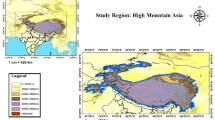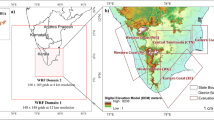Abstract
In the present study, we have used TRMM multi-satellite precipitation analysis (TMPA) 3B42 and global precipitation mission (GPM): IMERG “precipitation Cal” products to identify and quantify the asymmetry and distribution of rainfall in tropical cyclones formed over Bay of Bengal (BoB). For the period 2010–2013, TMPA products have been made use of and for the period 2014–2017, GPM–IMERG products are used to study the aforementioned features. Overall, 17 cyclones covering 75 events/days ranging from depression to very severe cyclonic stage of the system have been analysed. Our analysis revealed some interesting features on asymmetry, direction of maximum rain-receiving zones, relation of T-number with maximum and total rainfall in rain-receiving areas. The study reveals the direction of rainfall zone is mostly towards west and southwest directions of the storm centre in BoB. This point gains importance in the context of earlier reports, where it is mentioned that the direction of maximum rainfall is in east. The study also infers that the maximum rainfall and total rainfall need not be dependent on the intensity (indicated by T-number). We also attempted to classify the rain-receiving zones, based on both the rainfall-rate window and area covered in each window of rainfall, and a criterion has been proposed. The distribution of rainfall is classified, as sharply falling, slowly falling and nearly constant.









Similar content being viewed by others
References
Alvey GR, Zawislak J, Zipser E (2015) Precipitation properties observed during tropical cyclone intensity change. Mon Weather Rev 143:4476–4492
Atallah EH, Bosart LF (2003) The extratropical transition and precipitation distribution of Hurricane Floyd (1999). Mon Weather Rev 131:1063–1081
Balachandran S, Geetha B (2014) Characterisation and asymmetry analysis of rainfall distribution associated with tropical cyclones over Bay of Bengal: NISHA (2008), LAILA (2010) and JAL (2010). Mausam 65(4):481–496
Blackwell KG (2000) The evolution of Hurricane Danny (1997) at landfall: Doppler-observed eyewall replacement, vortex contraction/intensification, and low-level wind maxima. Mon Weather Rev 128:4002–4016
Burpee RW, Black ML (1989) Temporal and spatial variations of rainfall near the centres of two tropical cyclones. Mon Weather Rev 117:2204–2218
Chaudhuri S, Dutta D, Goswami S, Middey A (2015) Track and intensity forecast of tropical cyclones over the North Indian Ocean with multilayer feed forward neural nets. Meteor App 22:563–575
Chen Y, Ebert EE, Walsh KJE, Davidson NE (2013) Evaluation of TRMM 3B42 precipitation estimates of tropical cyclone rainfall using PACRAIN data. J Geophys Res Atmos 118:2184–2196. https://doi.org/10.1002/jgrd.50250
Dunn GE, Miller BI (1960) Atlantic hurricanes. Louisiana State University Press, Baton Rouge
Emanuel KAV (2005) Increasing destructiveness of tropical cyclones over the past 30 years. Nature 436:686–688
Hou AY, Kakar RK, Neeck S, Azarbarzin AA, Kummerow CD, Kojima M, Oki R, Nakamura K, Iguchi T (2013) The global precipitation measurement mission. Bull Am Meteor Soc 95(5):701–722
Huffman GJ, Adler RF, Bolvin DT, Gu G, Nelkin EJ, Bowman KP, Hong Y, Stocker EF, Wolff DB (2007) The TRMM multisatellite precipitation analysis (TMPA) quasiglobal multiyear, combined-sensor precipitation estimates at fine scale. J Hydrometeorol 8:38–55
Huffman GJ, Bolvin D, Braithwaite T, Hsu DK, Joyce R, Kidd C, Nelkin EJ, Xie P (2015) NASA global precipitation measurement (GPM) Integrated multi-satellite retrievals for GPM (IMERG), algorithm theoretical. Basis document. Version 4.5
Jiang H, Liu C, Zipser EJ (2010) A TRMM-based tropical cyclone cloud and precipitation feature database. J App Meteor Clim 50(6):1255–1273
Kikuchi K, Wang B (2008) Diurnal precipitation regimes in the global tropics. J Clim 21:2680–2696
Koteswaram P, Gaspar S (1956) The surface structure of tropical cyclones in the Indian area. Indian J Meteor 7:339–352
Krishna UV, Das SK, Deshpande SM, Doiphode SL, Pandithurai G (2017) The assessment of global precipitation measurement estimates over the Indian subcontinent. Earth Space Sci 4:540–553
Kumar P, Kishtawal CM, Pal PK (2014) Impact of satellite rainfall assimilation on weather research and forecasting model predictions over the Indian region. J Geophys Res Atmos 119:2017–2031
Liu Z (2016) Comparison of integrated multisatellite retrievals for GPM (IMERG) and TRMM multisatellite precipitation analysis (TMPA) monthly precipitation products: initial results. J Hydrometeorol 17(3):777–790
Lonfat M, Marks FD, Chen SS (2004) Precipitation distribution in tropical cyclones using the tropical rainfall measuring mission (TRMM) microwave imager: a global perspective. Mon Weather Rev 132:1645–1660
Miller BL (1964) A study of the filling of Hurricane Donna (1960) over land. Mon Weather Rev 92:389–406
Muller CJ, Romps DM (2018) Acceleration of tropical cyclogenesis by self-aggregation feedbacks. In: Proceedings of the National Academy of Science, (PNAS), USA, 5 March 2018, p 201719967. https://doi.org/10.1073/pnas.1719967115
Parrish JR, Burpee RW, Marks FD Jr, Grebe R (1982) Rain patterns observed by digitized radar during the landfall of Hurricane Frederic (1979). Mon Weather Rev 110:1933–1944
Powell MD (1982) The transition of the Hurricane Frederic boundary-layer wind field from the open Gulf of Mexico to landfall. Mon Weather Rev 110:1912–1932
Powell MD (1987) Changes in the low-level kinematic and thermodynamic structure of Hurricane Alicia (1983) at landfall. Mon Weather Rev 115:75–99
Prakash S, Mitra AK, AghaKouchak A, Liu Z, Norouzi H, Pai DS (2016) A preliminary assessment of GPM-based multi-satellite precipitation estimates over a monsoon dominated region. J Hydrometeorol. https://doi.org/10.1016/j.jhydrol.2016.01.029
Rodgers CS, Pierce HF (1994) A satellite observational and numerical study of precipitation characteristics in western North Atlantic tropical cyclones. J Appl Meteor 33:129–139
Rodgers EB, Adler RF, Pierce HF (2000) Contribution of tropical cyclone rainfall to the North Pacific climatological rainfall as observed from satellites. J Appl Meteor 39:1658–1678
Rodgers EB, Adler RF, Pierce HF (2001) Contribution of tropical cyclone rainfall to the North Atlantic climatological rainfall as observed from satellites. J Appl Meteor 40:1785–1800
Sebastian M, Behera MR (2015) Impact of SST on tropical cyclones in North Indian Ocean. In: 8th international conference on Asian and Pacific Coasts (APAC 2015)
Singh K, Panda J, Osuri KK, Vissa NK (2016) Progress in tropical cyclone predictability and present status in the North Indian ocean region. In: Lupo A (ed) Recent developments in tropical cyclone dynamics, prediction, and detection. InTech, The Hague. https://doi.org/10.5772/64333
Srinivas CV, Bhaskar Rao DV, Yesubabu V, Baskaran R, Venkatraman B (2013) Tropical cyclone predictions over the Bay of Bengal using the high-resolution advanced research weather research and forecasting model. Q J R Meteorol Soc 139:1810–1825
Tapiador FJ et al (2012) Global precipitation measurement: methods, datasets and applications. Atmos Res 104–105:70–97
Uma R, Lakshmi Kumar TV, Narayanan MS, Rajeevan M, Bhate J, Niranjan K (2013) Assessment and spatial correspondence of TRMM and IMD gridded data sets over Indian land mass. J Earth Syst Sci 122(3):573–588
Webster PJ, Holland GJ, Curry JA, Chang HR (2005) Changes in tropical cyclone number, duration, and intensity in a warming environment. Science 309(5742):1844–1846
Wingo MT, Cecil DJ (2010) Effects of vertical wind shear on tropical cyclone precipitation. Mon Weather Rev 138:645–662
Xiao Z, Duan A (2015) Can the tropical storms originated from the Bay of Bengal impact the precipitation and soil moisture over the Tibetan Plateau? Sci China Earth Sci 58:915
Xie P, Chen M, Yang S, Yatagai A, Hayasaka T, Fukushima Y, Liu C (2007) A gauge-based analysis of daily precipitation over East Asian. J Hydrometeorol 8:607–626
Yong B, Liu D, Gourley JJ, Tian Y, Huffman GJ, Ren L, Hong Y (2014) Global view of real-time TRMM multisatellite precipitation analysis: implications for its successor global precipitation measurement mission. Bull Am Meteor Soc 96(2):283–296
Yu Z, Wang Y, Xu H (2015) Observed rainfall asymmetry in tropical cyclones making landfall over China. J Appl Meteor Clim 54:117–136. https://doi.org/10.1175/jamc-d-13-0359.1
Yu Z, Wang Y, Xu H, Davidson N, Chen Y, Chen Y, Yu H (2017) On the relationship between intensity and rainfall distribution in tropical cyclones making landfall over China. J Appl Meteor Clim 56(10):2883–2901
Acknowledgements
The author Mr. Manoj Kumar Thakur is thankful to Silver Jubilee Scholarship Scheme-Govt. of India under which he is sponsored.
Author information
Authors and Affiliations
Corresponding author
Rights and permissions
About this article
Cite this article
Thakur, M.K., Lakshmi Kumar, T.V., Dwivedi, S. et al. On the rainfall asymmetry and distribution in tropical cyclones over Bay of Bengal using TMPA and GPM rainfall products. Nat Hazards 94, 819–832 (2018). https://doi.org/10.1007/s11069-018-3426-5
Received:
Accepted:
Published:
Issue Date:
DOI: https://doi.org/10.1007/s11069-018-3426-5




